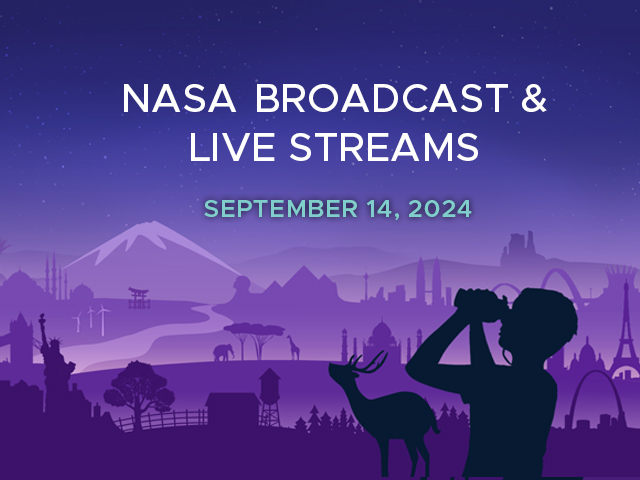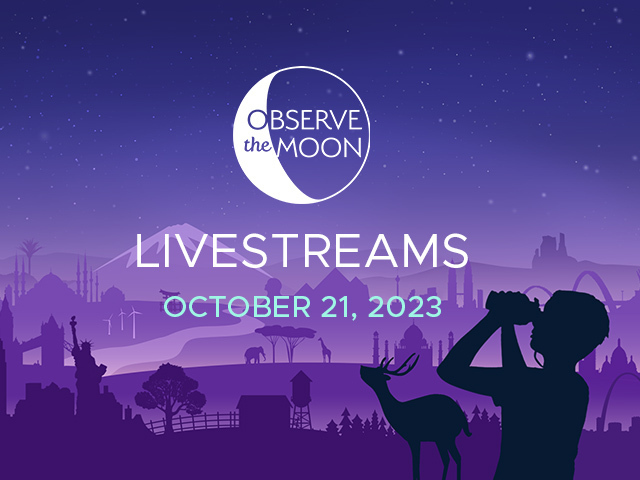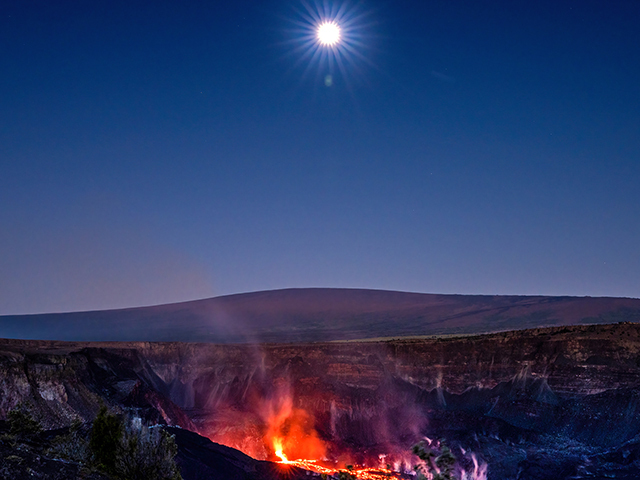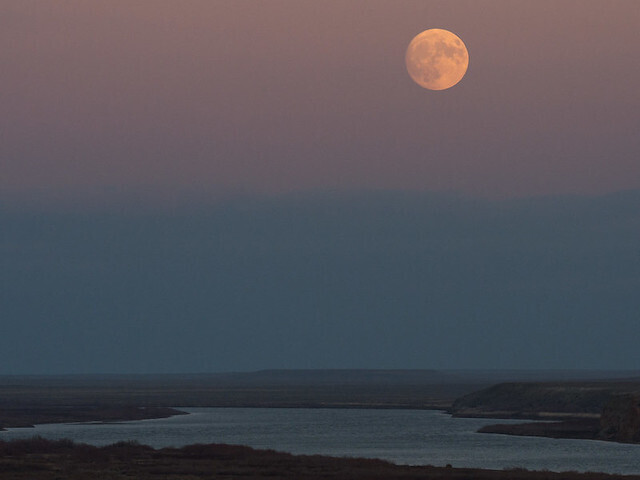News | July 2, 2017
The Next Full Moon is the Guru Purnima, Hay Moon, Mead Moon, Honeymoon, Rose Moon, Buck Moon or Thunder Moon.

Taken August 18, 2016 by Commander Jeff WIlliams of NASA during Expedition 48 on the International Space Station. More ›
The Next Full Moon is the Guru Purnima, Hay Moon, Mead Moon, Honeymoon, Rose Moon, Buck Moon, or Thunder Moon.
The next full Moon will be just after midnight between Saturday July 8 and Sunday July 9, appearing "opposite" the Sun (in Earth-based longitude) at 12:07 AM EDT on Sunday morning, July 9, 2017. The Moon will appear full for about three days centered on this time, from sunset on Friday through sunrise on Monday, making this a full Moon weekend!
This full Moon has many names:
- For Hindus, this is the Guru Full Moon (Guru Purnima) and is celebrated as a time for clearing the mind and honoring the guru or spiritual master. For more information see https://en.wikipedia.org/wiki/Guru_Purnima for example.
- Europeans called July's full Moon the Hay Moon or the Mead Moon. Mead is created by fermenting honey mixed with water, sometimes adding fruits, spices, grains, or hops. Another name for this full Moon is the honeymoon. According to Wikipedia: "In ancient times honeymoon referred to the time of year when bee honey was ripe and cured to be harvested from hives or from the wild, which made it the sweetest time of the year." This was usually around the Summer solstice at the end of June. The tradition of calling the first month of marriage the "honeymoon" may be tied to the custom of marrying in June, that the "honeymoon" is the sweetest month of the year, or from the custom of serving mead at the wedding and giving the couple enough honey wine to last their first month as newlyweds.
- Some call this the Rose Moon. This Moon is the full Moon that takes its lowest arc in the sky, shining through more atmosphere than at other times of the year, which can have a reddish or rose color (for much the same reasons that a rising or setting Sun appears red). Usually the full Moon in June is lowest, called the Rose Moon, but this year the July full Moon is slightly lower in the sky (see last month's Moon Missive for more on this). In general, the full Moon closest to the summer solstice will be the lowest for the year.
- The Maine Farmer's Almanac first published Indian names for the full Moons in the 1930's. According to this almanac, as the first full Moon of Summer, the Algonquin tribes in what is now the Eastern USA called this full Moon the Buck Moon. Early Summer is normally when the new antlers of buck deer push out of their foreheads in coatings of velvety fur. They also called this the Thunder Moon because of early Summer's frequent thunderstorms.
Since this is the Thunder Moon, a quick note on lightning safety. Most of the lighting that strikes the ground arcs from the negatively charged bottom of the storm to the ground underneath the storm. Much rarer is positive lightning, which arcs from the top of a thunderstorm to strike the ground up to eight miles away. Positive lightning can sometimes strike areas where the sky is clear (hence the term "bolt out of the blue"). Because it arcs across a greater distance it tends to be 5 to 10 times more powerful that regular ground strikes. Though positive lightning is rare (less than 5% of all lightning strikes), the lack of warning combined with its greater power tends to make it fatal more often. A good rule to follow is, if you can hear the thunder, you can be struck by the lightning. As a bicycle commuter, I am well aware that the inch or so of rubber tire between my metal bicycle and the ground will make little difference to a bolt that can arc across miles of air from the top of a thunderstorm to the ground. Be safe!
As usual, the wearing of suitably celebratory celestial attire is encouraged in honor of the full Moon.
In lunisolar calendars the months change with the new Moon and full Moons fall in the middle of the lunar month. This full Moon is the middle of the sixth month of the Chinese calendar and Tammuz in the Hebrew calendar. In the Islamic calendar the months start with the first sighting of the waxing crescent Moon a few days after the New Moon. This full Moon is near the middle of Shawwal.
As usual, the wearing of suitably celebratory celestial attire is encouraged in honor of the full Moon. In addition, take care to stay safe during thunder storms, "make hay while the sun shines," and take a moment to clear your mind.
As for other celestial events between now and the full Moon after next:
As Summer begins, the daily periods of sunlight have passed their longest and are beginning to shorten again. Our 24-hour clock uses the average length of the solar day throughout the year, but near the solstices the solar days are longer. This means the earliest sunrises of the year occur before the summer solstice and the latest sunsets of the year occur after the solstice. For the Washington, DC area, rounded to the minute, the latest sunsets of the year will be at 8:37 PM EDT from Tuesday, June 20 until Wednesday, July 5, 2017. On the day of the June full Moon, morning twilight will begin at 4:40 AM, sunrise will be at 5:51 AM, the Sun will reach a maximum altitude of 73.4 degrees at 1:13 PM, sunset will be at 8:46 PM, and evening twilight will end at 9:45 PM EDT. By the day of the August full Moon, morning twilight will begin at 5:10 AM, sunrise will be at 6:15 AM, the Sun will reach a maximum altitude of 67.3 degrees at 1:14 PM, sunset will be at 8:12 PM, and evening twilight will end at 9:17 PM EDT.
On the evening of the July full Moon, as evening twilight ends (at 9:47 PM EDT for the Washington, DC area), the bright planet Jupiter appears high in the southwest (31 degrees above the horizon for the DC area). With a backyard telescope the four large moons of Jupiter should be clearly visible, changing noticeably in the course of an evening. The planet Saturn, less bright than Jupiter but still near its brightest for the year, appears in the south-southwest (at 25 degrees above the horizon for the DC area). With a backyard telescope the next few months will be a good time to look for Saturn's rings and its largest moon, Titan. The planet Mercury will be setting as evening twilight ends, but will be bright enough to be visible ow in the west-northwest about 30 minutes after sunset. The "Summer Triangle" will appear high in the east. The "Summer Triangle" is not a constellation but consists of three bright stars from three different constellations. Look east, to the left is Deneb, the brightest star in the constellation Cygnus the Swan; in the upper middle is Vega, the brightest star in the constellation Lyra the Harp; and to the right is Altair, the brightest star in the constellation Aquila the Eagle. As the month progresses Jupiter, Saturn, and the stars will appear to shift more towards the west, while Mercury will appear to shift along the horizon from west-northwest more towards the west. Mercury will appear at its highest above the horizon at the time evening twilight ends on July 20, 2017, and reach its greatest angular separation from the Sun as seen from Earth on July 29, 2017. By the evening of the August full Moon, Jupiter will have shifted to the west-southwest (at about 17 degrees above the horizon for the Washington, DC area), and Saturn will appear in the south (at about 29 degrees above the horizon).
In the morning on the night of the July full Moon, as morning twilight begins (at 4:40 AM EDT for the Washington, DC area), the planet Venus as the morning star will appear in the east (at about 17 degrees above the horizon). The bright star near Venus is Aldebaran (they will appear at their closest on Thursday, July 13, 2017). Throughout the month Venus will appear to shift slightly higher in the morning sky and more to the east-northeast.
There will be several meteor showers active between now and the full Moon after next. Any night during this period, if you happen to be out in an area with dark skies and no Moon on a clear night after midnight, you just might see a meteor or two.
The Alpha Capricornids should be active from July 11 to August 10. This shower typically produces only about 10 meteors per hour, but I mention it because it has a fairly broad peak centered around Saturday, July 29, 2017, and occasionally produces bright fireballs. These meteors are thought to be caused by dust from the comet 169P/NEAT that enter our atmosphere at a relatively "slow" 24 kilometers per second (54,000 miles per hour).
The Southern Delta Aquariids should be active from around July 21 through August 23, peaking the night of Saturday, July 29 into the morning of Sunday, July 30, 2017. This shower is best seen from the southern hemisphere, usually produces faint meteors without persistent trails, rarely produces fireballs. The best time to look will be after the first quarter Moon has set. The Delta Aquarids are probably caused by dust from the the short period comet 96P/Machholz or from the breakup of what are now the Marsden and Kracht Sungrazing comets that enter our atmosphere at 41 kilometers per second (92,000 miles per hour).
The Perseids are usually one of the best meteor showers of the year. The Perseids should be active from July 13 to August 29, peaking the morning of Saturday, August 12, 2017. This year the light of the nearly full waning gibbous Moon will interfere with viewing the Perseids during its peak. The Perseid meteors are caused by dust from the comet 109P/Swift-Tuttle that enters our atmosphere at 58 kilometers per second (130,000 miles per hour).
Even though they are not visible usually, I include in these Moon missives information about Near Earth Objects (mostly asteroids) that pass the Earth within about 10 lunar distances, because I find it interesting that we have discovered so many.
On Monday morning, July 3, 2017 at 10:12 AM EDT (2017-Jul-03 14:12 UTC), Near Earth Object (2017 MO8), between 17 and 38 meters (55 to 123 feet) in diameter, will pass the Earth at 4.1 lunar distances, traveling at 10.93 kilometers per second (24,453 miles per hour).
On Monday morning, July 3, 2017 at 10:41 AM EDT (2017-Jul-03 14:41 UTC), Near Earth Object (2017 ME4), between 15 and 34 meters (50 to 112 feet) in diameter, will pass the Earth at between 5.3 and 5.4 lunar distances (nominally 5.4), traveling at 6.77 kilometers per second (15,137 miles per hour).
Monday afternoon, July 3, 2017, at 4:11 PM EDT, the Earth will be at aphelion, its farthest away from the Sun in its orbit, 3.4% farther from the Sun than it was at perihelion in early January. Since the intensity of sunlight drops off as the square distance, the sunlight reaching the Earth at aphelion will be about 6.5% less bright than sunlight reaching the Earth at perihelion.
Thursday morning, July 6, 2017, at 12:27 AM EDT, the Moon will be at apogee, at 405,934 km (252,236 miles) its farthest from the Earth for this orbit.
On Thursday, July 6, 2017, the bright planet Saturn will appear below the nearly full Moon. For the Washington, DC area, evening twilight will end at 9:48 PM, the Moon will reach its highest in the sky at 11:37 PM, Saturn will set Friday morning at 4:22 AM, morning twilight will end around 4:39 AM, and the Moon will set at 4:43 AM EDT.
As mentioned above, the next full Moon will be just after midnight between Saturday and Sunday, at 12:07 AM EDT on July 9, 2017.
On Monday night, July 10, 2017 at 10:03 PM EDT (2017-Jul-11 02:03 UTC with 4 minutes uncertainty), Near Earth Object (2017 MC4), between 116 and 259 meters (381 to 851 feet) in diameter, will pass the Earth at between 7.5 and 7.7 lunar distances (nominally 7.6), traveling at 20.74 kilometers per second (46,399 miles per hour).
Thursday morning, July 13, 2017, the star Aldebaran appears in the east below and o the right of the bright planet Venus (as the morning star).
On Friday night, July 14, 2017 at around 11 PM EDT (2017-Jul-15 02:55 UTC with 58 minutes uncertainty), Near Earth Object (2017 MR8), between 27 and 59 meters (87 to 195 feet) in diameter, will pass the Earth at between 3.2 and 3.4 lunar distances (nominally 3.3), traveling at 6.89 kilometers per second (15,413 miles per hour).
Sunday afternoon, July 16, 2017, the waning Moon will appear half-full, reaching its last quarter at 3:26 EDT.
On Thursday morning, July 20, 2017, the bright planet Venus as the morning star will appear to the left of the waning crescent Moon, with the bright star Aldebaran off to the right. For the Washington, DC area, Aldebaran will rise at 2:53 AM, Venus will rise at 3:05 AM, the Moon will rise at 3:12 AM, and morning twilight will begin around 4:50 AM EDT (when the Moon will be about 17 degrees above the eastern horizon). The Moon and Aldebaran will appear almost to touching the afternoon of the day before, but we will not be able to to see them.
Friday afternoon, July 21, 2017, at 1:09 PM EDT, the Moon will be at perigee, its closest to the Earth for this orbit. At 361,236 km (224,462 miles), the Moon will be 11.0% closer than it was at apogee in early July and 10.8% closer than it will be at apogee in early August.
Sunday morning, July 23, 2017, at 5:46 AM EDT, will be the new Moon, when the Moon passes between the Earth and the Sun and will not be visible from the Earth. The New Moon marks the start of the new month for most lunisolar calendars. The next day marks the start of the seventh month of the Chinese calendar and Av in the Hebrew calendar.
On Sunday afternoon, July 23, 2017 at 3:17 PM EDT (2017-Jul-23 19:17 UTC), Near Earth Object (2017 BS5), between 40 and 90 meters (132 to 295 feet) in diameter, will pass the Earth at 3.1 lunar distances, traveling at 5.80 kilometers per second (12,984 miles per hour).
In the Islamic calendar the months start with the first sighting of the waxing crescent Moon a few days after the New Moon. Monday or Tuesday evening, July 24 or 25, 2017, will mark the beginning of Dhu al-Qidah, one of Islam's four sacred months during which warfare ins prohibited.
On Tuesday evening, July 25, 2017, you might be able to see the thin, waxing crescent Moon low in the west with the planet Mercury to the upper left and the bright star Regulus a bit farther to the upper left. You will need to look about 30 minutes after sunset, as the Moon will have set by the time evening twilight ends. For the Washington, DC area, 30 minutes after sunset will be at 8:56 PM, the Moon will set at 9:27 PM, evening twilight will end at 9:34 PM, Mercury will set at 9:41 PM, and Regulus will set at 9:47 PM EDT. Tuesday evening also happens to be the evening when the Mercury and Regulus appear at their closest together for this apparition.
Wednesday evening, July 26, 2017, at 7:59 PM EDT, is when the planet Mars passes on the far side of the Sun as seen from Earth, called conjunction.
On Friday evening, July 28, 201, the bright planet Jupiter will appear just below the waxing crescent Moon, with the bright star Spica off to the left. For the Washington, DC area, evening twilight will end around 9:30 PM, Jupiter will set at 11:29 PM, Spica will set at 11:32 PM, and the Moon will set at 11:46 PM EDT.
As noted above, after midnight Friday morning and again Saturday morning, July 28 and 29, 2017, is the predicted peak of the Southern Delta Aquariid meteor shower.
Saturday evening, July 29, 2017, is when the planet Mercury reaches its greatest angular separation from the Sun as seen from the Earth for this apparition, 27.2 degrees.
As noted above, after midnight Sunday morning, July 30, 2017, is the predicted peak of the Alpha Capricornid meteor shower.
On Sunday midday, July 30, 2017, the Moon will appear half-full as it reaches its first quarter at 11:23 AM EDT.
Wednesday, August 2, 2017, at 1:55 PM EDT, the Moon will be at apogee, at 405,025 km (251,671 miles) its farthest from the Earth for this orbit.
On Wednesday evening, August 2, into Thursday morning, August 3, the bright planet Saturn will appear below and to the left of the waxing gibbous Moon. For the Washington, DC area, evening twilight will end around 9:23 PM EDT, just about 10 minutes before the Moon reaches its highest in the sky for the evening. Saturn will set Thursday morning at 2:31 AM and the Moon will set about 9 minutes later.
The full Moon after next will be on Monday, August 7, 2017, at 2:11 PM EDT. The Moon will fall into the partial shadow of the Earth, but this will not be at a time when we cannot see it from the Americas.






